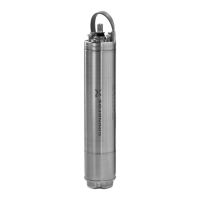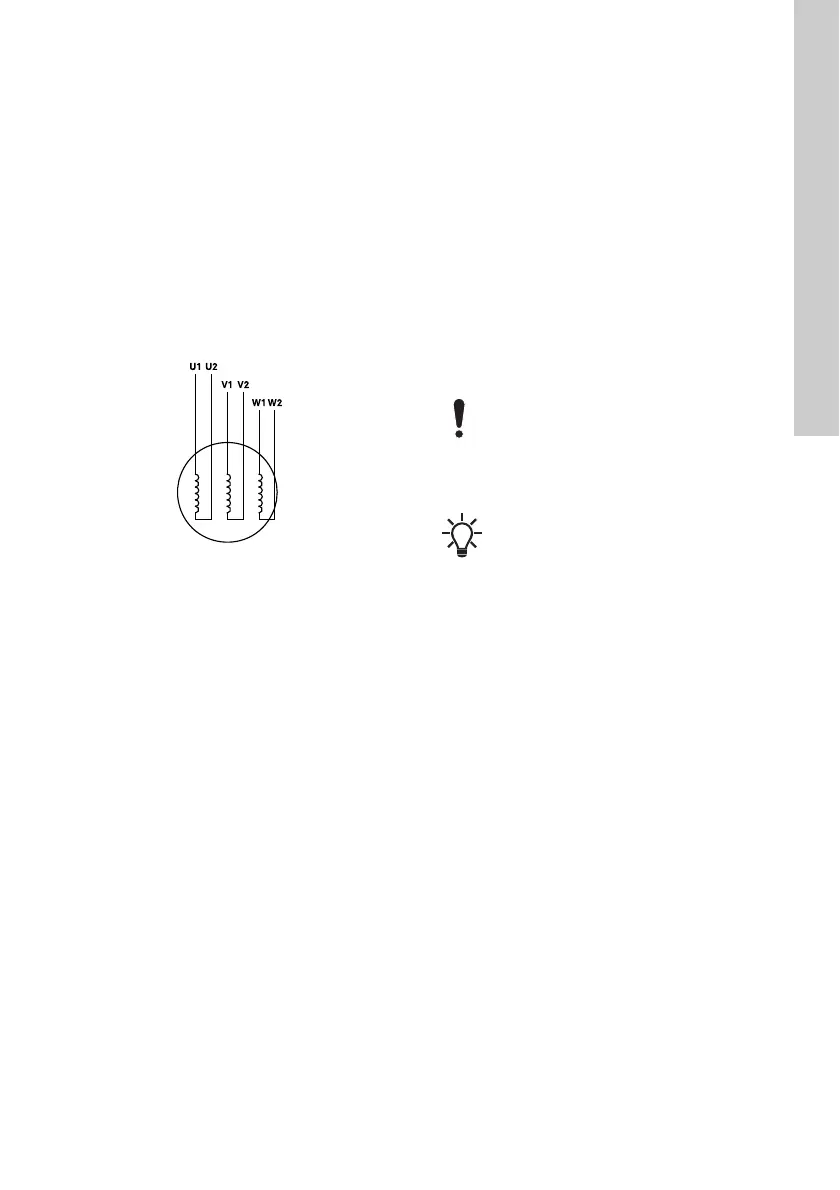English (GB)
15
5.6.4 Connection in the case of unidentified cable
marking/connection
If it is unknown where the individual leads are to be
connected to the mains in order to ensure the correct
direction of rotation, proceed as follows:
Motors wound for direct-on-line starting
Connect the motor to the mains as it is expected to
be right.
Then check the direction of rotation as described in
section 5.5.4 Checking the direction of rotation of the
motor.
Motors wound for star-delta starting
Determine the windings of the motor by means of an
ohmmeter, and name the lead sets for the individual
windings accordingly: U1-U2, V1-V2, W1-W2. See
fig. 16.
Fig. 16 Unidentified cable marking/connection -
motors wound for star-delta starting
If star-delta starting is required, connect the leads as
shown in fig. 13.
If direct-on-line starting is required, connect the
leads as shown in fig. 14.
Then check the direction of rotation as described in
section 5.5.4 Checking the direction of rotation of the
motor.
5.6.5 Soft starter
Grundfos only recommends the use of soft starters
that control the voltage on all three phases and are
provided with a bypass contact.
Ramp time: Maximum 3 seconds.
For further details, please contact your soft starter
supplier or Grundfos.
5.6.6 Frequency converter
Three-phase MS asynchronous submersible motors
can be connected to a frequency converter.
Three-phase MS6000P synchronous submersible
motors must be connected to a frequency converter
of VSI type and an IPM-ready sine wave filter.
MMS motors with PE/PA can be connected to a
frequency converter.
To avoid EMC problems, it is required to use
shielded cables between the frequency converter
and the sine wave filter, and in EMC sensitive
installations from the sine wave filter to the entrance
of the borehole.
The cable shield must be connected to the sine wave
filter and the borehole lining, if the latter is
conductive.
For asynchronous motors:
Permissible frequency ranges:
• 30-50 Hz
• 30-60 Hz.
Ramp time: Maximum 3 seconds from standstill to
minimum frequency and vice versa.
For synchronous motors MS6000P:
Permissible frequency ranges:
• 55-100 Hz
• 55-120 Hz.
Ramp time: Maximum 3 seconds from standstill to
minimum frequency and vice versa
Depending on the type, the frequency converter may
cause increased acoustic noise from the motor.
Furthermore, it may expose the motor to detrimental
voltage peaks. This can be prevented by installing an
LC filter, or a sine wave filter between the frequency
converter and the motor. Grundfos recommends that
a sine wave filter be used in all SP installations with
voltages above 380 V.
For further details, contact your frequency converter
supplier or Grundfos.
TM00 1367 5092
During frequency converter operation, it is
not advisable to run the motor at a
frequency higher than the rated frequency
(50 or 60 Hz). In connection with pump
operation, it is important never to reduce
the frequency (and consequently the
speed) to such a level that the necessary
flow of cooling liquid past the motor is no
longer ensured.
To enable monitoring of the motor
temperature, Grundfos recommends that a
Pt100 or a Pt1000 be installed.

